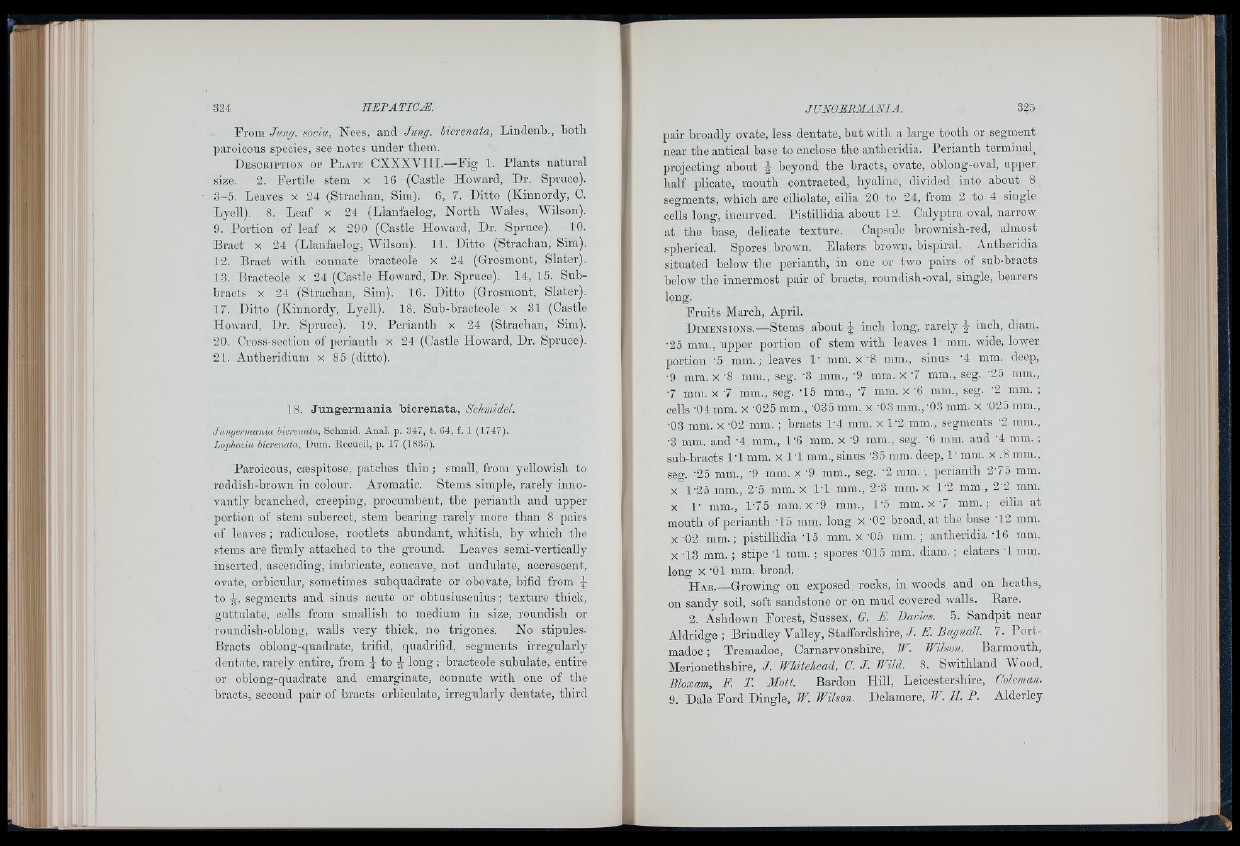
From .lung, socia, Nees, and Jtmg. hicrenata, Lindenb., both
paroicous species, see notes under them.
D escription op P late CXXXVIII.—Fig 1. Plants natural
size. 2. Fertile stem x 16 (Castle Howard, Dr. Spruoe).
3-5. Leaves x 24 (Strachan, Sim). 6, 7. Ditto (Kinnordy, C.
Lyell). 8. Leaf x 24 (Llanfaelog, North AVales, Wilson).
9. Portion of leaf x 290 (Castle Howard, Dr. Spruoe). 10.
Bract X 24 (Llanfaelog, AVilson). 11. Ditto (Strachan, Sim).
12. Bract with connate bracteole x 24 (Grosmont, Slater).
13. Bracteole x 24 (Castle Howard, Dr. Spruce). 14, 15. Subbracts
X 24 (Strachan, Sim). 16. Ditto (Grosmont, Slater).
17. Ditto (Kinnord)', Lyell). 18. Sub-braoteole x 31 (Castle
Howard, Dr. Spruoe). 19. Perianth x 24 (Strachan, Sim).
20. Cross-section of perianth x 24 (Castle Howard, Dr. Spruoe).
21. Antheridium x 85 (ditto).
18. Jungermania bicrenata, Schmidel.
.Tungermania hicrenata, Schmid. Anal. p. 847, t. 64, f. 1 (1747).
Lophozia hicrenata, Dum. Recueil, p. 17 (1835).
Paroicous, cæspitose, patches thin ; small, from yellowish to
reddish-brown in colour. Aromatic. Stems simple, rarely iimo-
vantly branched, creeping, procumbent, the perianth and upper
portion of stem suberect, stem bearing rarely more than 8 pairs
of leaves ; radiculose, rootlets abundant, whitish, by which the
stems are firmly attached to the ground. Leaves semi-vertioally
inserted, ascending, imbricate, concave, not undulate, accrescent,
ovate, orbicular, sometimes suhquadrate or obovate, bifid from J
to if, segments and siniis acute or obtusiusculus ; texture thick,
suttulate, cells from smallish to medium in size, roundish or
roundish-oblong, walls very thick, no trigones. No stipules-
Braots oblong-quadrate, trifid, quadrifid, segments irregularly
dentate, rarely entire, from ^ to ^ long ; bracteole subulate, entire
or oblong-quadrate and emarginate, connate with one of the
bracts, second pair of bracts orbiculate, irregularly dentate, third
pair broadly ovate, less dentate, but with a large tooth or segment
near the antical base to enclose the antheridia. Perianth terminal^
projecting about J beyond the bracts, ovate, oblong-oval, upper
half plicate, mouth contracted, hyaline, divided into about 8
segments, which are ciliolate, cilia 20 to 24, from 2 to 4 single
cells long, incurved. Pistillidia about 12. Calyptra oval, narrow
at the base, delicate texture. Capsule brownish-red, almost
spherical. Spores brown. Elaters brown, bispiral. Antheridia
situated below the perianth, in one or two pairs of snb-bracts
below the innermost pair of bracts, roundish-oval, single, bearers
long.F
ruits March, April.
D imensions.'—Stems about g- inch long, rarely ^ inch, diam.
■25 mm., upper portion of stem with leaves 1- mm. wide, lower
portion '5 mm.; leaves 1' mm. x '8 mm., sinus '4 mm. deep,
•9 mm. x -8 mra., seg. '3 m m .,'9 mm. x 7 mm., seg. '25 mm.,
7 mm. X 7 mm,, seg. T5 mm., 7 mm. x '6 mm., seg. '2 mm. ;
cells •04 mm. x '025 mm., ’035 mm. x '03 mm.,'03 mm. x '025 ram.,
•03 mm. x '02 mm. ; bracts 1'4 mm. x 1'2 mm., segments '2 mm.,
■3 mm. and '4 mm., 1'6 mm. x '9 mm., seg. '6 mra. and '4 mm. ;
sub-braots I 'l mm. x I 'l mm., sinus '35 mm. deep, 1’ mm. x .8 mm.,
seg. '25 mm., '9 mm. x '9 mm., seg. -2 ram. , perianth 2'75 mm.
X 1-25 mm., 2’5 mm. x I 'l mm., 2'S mm.x 1'2 mm., 2'2 mm.
X 1- mm., 1-75 mm. X '9 mm., i ’5 mm. x '7 mm.; cilia at
mouth of perianth 'lo mm. long x '02 broad, at the base ’12 mm.
X -02 mm.; pistillidia '15 mm. x '05 mm. ; antheridia '16 mm.
X '13 mm. ; stipe '1 mm. ; spores '015 mm. diam. ; elaters '1 mm.
long X -01 mm. broad.
H ab.—Growing on exposed roolis, in woods and on heaths,
on sandy soil, soft sandstone or on mud covered walls. Eare.
2. Ashdown Forest, Sussex, G. E. Bavies. 5. Sandpit near
Aldridge; Brindley Valley, Staffordshire,-7. A. 7. Portmadoo;
Tremadoc, Carnarvonshire, W. Wilson. Barmouth,
Merionethshire, J. Whitehead, C. J. Wild. 8. Swithland AVood,
Btoxam, F. T. Mott. Bardon Hill, Leicestershire, Coleman.
9. Dale Ford Dingle, W. Wilson. Delamere, W. H. P. Alderley